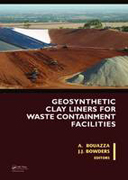
Geosynthetic clay liners for waste containment facilities
Bouazza, Abdelmalek
Bowders, John L.
This book gives a comprehensive and authoritative review of the current stateof practice on geosynthetic clay liners in waste containments. It provides aninsight into individual materials (bentonite and the associated geosynthetics) and the manufacturing processes. This is followed by the coverage of important topics such as hydraulic conductivity, chemical compatibility, contaminant transport, gas migration, shear strength and slope stability, and field performance. INDICE: 1. Background and overview of geosynthetic clay liners 1 Introduction 2 Background 3 Current GCL products 4 Test methods and properties 5 Equivalency issues 6 Summary 2. Durability and lifetime of the geotextile fibers of geosynthetic clay liners 1 Introduction and background 2 Structure and degradation of polymer fibers 3 Stabilization of polypropylene (and polyethylene) fibers 4 Antioxidants depletion mechanisms 5 External environmental effects on oxidation 6 Durability evaluation and specification 7 Geomembranes and geofilm 8Summary and conclusions 3. Mineralogy and engineering properties of Bentonite1 Introduction 2 Mineralogy of smectite 3 Adsorption and swelling behavior 4 Engineering properties and their measurement 5 Closing remarks 4. Hydraulic conductivity of geosynthetic clay liners 1 Geosynthetic clay liners in bottom liners and top covers 2 Definitions 3 Hydraulic conductivity testing 4 Intact GCLs 5 Overlapping GCLs and other special situations 6 Chemical compatibility 5.Contaminant transport through GCL-based liner systems 1 Introduction 2 Modeling contaminant transport through GCLs 3 Establishing diffusion and sorption parameters for GCLs 4 Factors influencing diffusion and sorption coefficients 5 Summary of diffusion and sorption coefficients to use for preliminary designs 6 Contaminant migration assessments of GCL liner systems 7 Conclusions 6. Chemico-osmosis and solute transport through Geosynthetic clay liners 1 Introduction 2 Thermodynamics of irreversible processes 3 Experimental data 4 Physical interpretation of transport parameters 5 Role played by osmotic phenomena in contaminant transport through GCLs 6 Conclusions 7. Gas permeability of geosynthetic clay liners 1 Introduction 2 Background 3 Gas transport due to advection 4 Gas permeameter 5 Gas permeability 6 Conclusions 8. Internal and interface shear strength of geosynthetic clay liners 1 Introduction 2 Materials 3 GCL Shear strength testing equipment 4 Testing procedures 5 GCL Internal shear strength 6 GCL-GM Interface shear strength 7 Laboratory and field shear strength comparisons 8 Conclusions 9. Slope stability with geosynthetic clay liners 1 Introduction 2 Methods of analysis 3 Design criteria 4 Design shear strength for GCLs 5 Approaches to mitigate stability problems 6 Design examples 7 Conclusions 10. Hydrologic performance of final covers containing 1 Introduction 2 Covers relying solely on a GCL 3 Covers with a GCL-composite barrier 4 Practical implications 11. Oxygen diffusion through geosynthetic clay liners 1 Introduction 2 Background 3 Oxygen diffusion measurement 4 Oxygen diffusion coefficient 5Concluding remarks 12. Field observations of GCL behaviour 1 Introduction 2 GCL performance in composite liner systems 3 Case histories of field performance 4 Conclusions
- ISBN: 978-0-415-46733-9
- Editorial: Routledge
- Encuadernacion: Cartoné
- Páginas: 254
- Fecha Publicación: 16/11/2009
- Nº Volúmenes: 1
- Idioma: Inglés
